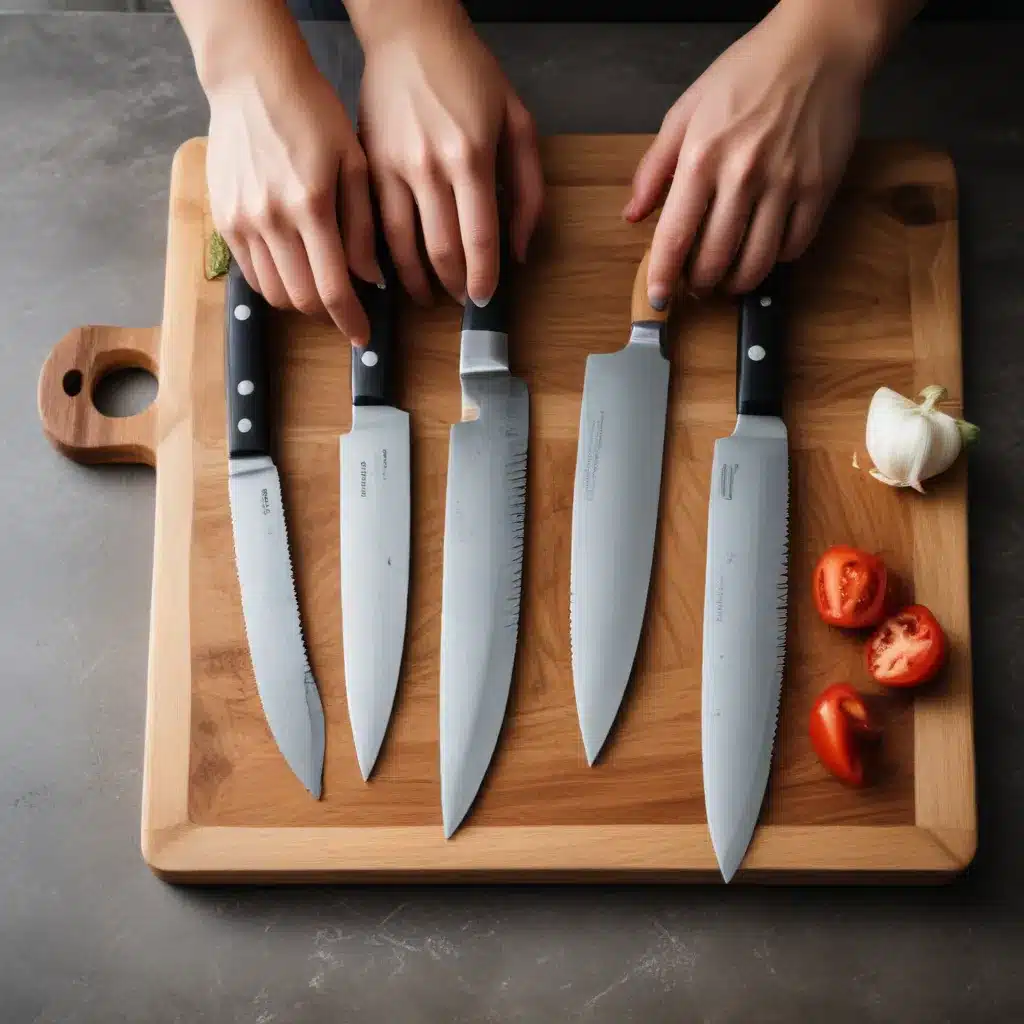
Mastering the Essentials: Knife Basics Every Home Cook Should Know
As a seasoned culinary professional, I’ve had the privilege of guiding countless home cooks towards honing their knife skills. One thing I’ve learned over the years is that the key to becoming a confident and efficient home cook lies in mastering the fundamentals of knife work. Whether you’re slicing, dicing, or mincing, having a firm grasp of the basic knife techniques can truly transform your cooking experience.
In this comprehensive guide, we’ll delve into the essential knife skills every home cook should possess. From understanding the anatomy of a knife to mastering proper cutting techniques, you’ll leave this article armed with the knowledge and confidence to tackle any kitchen task with ease.
Understanding Knife Anatomy and Construction
Before we dive into the specifics of knife skills, it’s important to have a basic understanding of knife anatomy and construction. This knowledge will not only help you select the right knife for the job but also inform how you handle and maintain your blades.
Blade Construction: Forged vs. Stamped
Knives can be broadly categorized into two main types based on their construction: forged and stamped.
Forged Blades: Forged blades are created by heating a single, thick piece of steel and then pounding it under extreme pressure using a hammer and die. This process results in a blade that is generally thicker, heavier, and more durable than its stamped counterpart. Forged knives often feature a bolster, a thick piece of metal where the blade meets the handle, which can provide better balance and protection for the user’s fingers.
Stamped Blades: Stamped blades, on the other hand, are cut or “stamped” from a sheet of steel, much like a cookie cutter shapes cookies from dough. Stamped knives are typically lighter and more affordable than forged knives, but they may not be as durable or well-balanced.
While forged knives are often considered the superior choice, there are many high-quality stamped knives on the market that can more than hold their own in the kitchen. The most important factor is how the knife feels in your hand and how effectively it performs the tasks you need it to accomplish.
Blade Material: Carbon Steel vs. Stainless Steel
Knives can also be distinguished by the type of steel used in their blades. The two most common materials are carbon steel and stainless steel.
Carbon Steel: Carbon steel was the metal of choice in the past, as it can achieve an exceptionally sharp edge. However, carbon steel is prone to rusting and dulling more quickly than stainless steel.
Stainless Steel: Stainless steel, on the other hand, is the more popular choice these days due to its resistance to corrosion and rust. While stainless steel blades may not be able to achieve the same level of sharpness as carbon steel, the higher the quality of the stainless steel, the sharper and longer-lasting the blade can be.
Many modern Japanese knives strike a balance by using a combination of carbon steel and stainless steel, offering the best of both worlds – exceptional sharpness with improved rust resistance.
Blade Length and Shape
The length and shape of a knife’s blade can also have a significant impact on its intended use. Common blade shapes include the chef’s knife, santoku, paring knife, and cleaver, each designed for specific tasks in the kitchen.
Chef’s Knife: The classic chef’s knife, typically ranging from 8 to 10 inches in length, is a versatile workhorse that can handle a wide variety of cutting tasks, from dicing vegetables to slicing meat.
Santoku Knife: The Japanese-style santoku knife, with its distinctive flat edge and slight curve, is well-suited for chopping, mincing, and slicing. Santoku knives are generally shorter than chef’s knives, usually around 6 to 7 inches in length.
Paring Knife: The small, nimble paring knife, with its 3 to 4-inch blade, is perfect for delicate tasks such as peeling, trimming, and deveining.
Cleaver: The heavy, rectangular cleaver is designed for cutting through tough materials, such as bones or thick cuts of meat. While not an essential tool for the home cook, a cleaver can be handy for those who work with whole chickens, ducks, or other bone-in meats.
Fundamental Knife Skills: Mastering the Basics
Now that we’ve covered the basics of knife anatomy and construction, let’s dive into the essential knife skills every home cook should possess.
Grip and Posture
The way you hold and position your knife can have a significant impact on your cutting efficiency and safety. The proper grip involves placing your thumb and index finger on either side of the blade, near the bolster (if present), with your remaining fingers wrapped around the handle. This grip, often referred to as the “chef’s grip,” provides you with maximum control and stability.
Maintaining good posture is also crucial. Stand with your feet shoulder-width apart, knees slightly bent, and your body turned slightly to the side. This stance will allow you to apply the necessary force while maintaining balance and control.
Cutting Techniques
Mastering the fundamental cutting techniques – slicing, dicing, mincing, and chopping – is the cornerstone of excellent knife skills. Let’s explore each of these techniques in detail:
-
Slicing: Slicing involves making long, smooth cuts through ingredients, producing thin, even pieces. To slice effectively, place the blade flat against the cutting board and use a gentle, back-and-forth motion to guide the knife through the food.
-
Dicing: Dicing refers to cutting ingredients into small, uniform cubes. Begin by slicing the food, then make perpendicular cuts to create the desired cube size.
-
Mincing: Mincing is the process of finely chopping ingredients, often used for herbs, garlic, or chilies. Grip the knife with your fingertips curled inward, then use a rapid, rocking motion to quickly chop the food into tiny pieces.
-
Chopping: Chopping involves using the full length of the blade to make decisive, downward cuts through ingredients. This technique is well-suited for larger items, such as onions or potatoes.
Remember to keep your fingers curled inward and your knuckles tucked under to protect your fingertips as you practice these cutting techniques. Consistent practice and attention to safety will help you develop the muscle memory and confidence to tackle any kitchen task.
Knife Sharpening and Maintenance
A sharp knife is not only more efficient but also safer to use than a dull blade. Mastering the art of knife sharpening is an invaluable skill for every home cook.
There are several methods for sharpening knives, but the most reliable and precise is using a whetstone. Whetstones come in varying grits, with coarser stones for restoring dull blades and finer stones for honing and polishing an edge.
When sharpening, hold the knife at a consistent angle, typically between 15 to 20 degrees, and use gentle, consistent strokes across the stone. This process takes some practice, but the rewards of having razor-sharp knives in your kitchen are well worth the effort.
In addition to sharpening, regular honing with a honing steel can help maintain the alignment of your knife’s edge between sharpenings. Honing does not remove metal from the blade but rather realigns the microscopic teeth along the edge, extending the time between full sharpenings.
By keeping your knives sharp and well-maintained, you’ll not only improve your cutting efficiency but also enhance the overall safety and enjoyment of your cooking experience.
Specialty Knife Skills: Elevating Your Culinary Prowess
While the fundamental knife skills are the foundation for any home cook, there are a few specialty techniques that can take your culinary prowess to the next level.
Julienne and Chiffonade
The julienne and chiffonade cuts are particularly useful for creating thin, uniform strips of ingredients, such as vegetables or herbs. The julienne technique involves slicing the food into long, thin matchstick-like pieces, while chiffonade refers to finely shredding or ribboning herbs or leafy greens.
Mastering these cuts can elevate the presentation and texture of your dishes, making them a valuable addition to your knife skills repertoire.
Carving and Trimming
The ability to carve and trim ingredients, such as roasts, whole chickens, or fish, can be a game-changer for the home cook. Proper carving techniques allow you to maximize the yield of your ingredients while ensuring clean, even slices.
When working with meat or poultry, always use a sharp, long-bladed carving knife or slicing knife to make clean, precise cuts. For fish, a flexible boning knife is the ideal tool for delicately trimming and filleting.
Decorative Cuts
While not necessarily essential for everyday cooking, learning to make decorative cuts can be a fun way to add a touch of flair to your culinary creations. Techniques such as fruit and vegetable carving, or creating intricate garnishes, can transform even the simplest dish into a visually stunning masterpiece.
These specialized knife skills may take time and practice to develop, but the payoff can be immensely rewarding, both in terms of improving your cooking abilities and impressing your family and guests.
Investing in the Right Knives
Now that you understand the fundamentals of knife skills, it’s time to discuss the importance of investing in the right knives for your kitchen. While you don’t need to break the bank to become a skilled home cook, having the appropriate tools can make a significant difference in your cooking experience.
Essential Knife Set for the Home Cook
At a minimum, every home cook should have the following knives in their arsenal:
-
Chef’s Knife: This is the workhorse of the kitchen, capable of handling a wide range of cutting tasks. A quality 8-inch or 10-inch chef’s knife is a must-have.
-
Paring Knife: A sharp, 3 to 4-inch paring knife is essential for delicate tasks, such as peeling, trimming, and deveining.
-
Serrated Knife: A good serrated knife is invaluable for slicing bread, tomatoes, and other soft-skinned produce.
-
Honing Steel: Regularly honing your knives with a high-quality honing steel will help maintain the alignment of the blade’s edge, extending the time between sharpenings.
While this basic set of knives is a great starting point, you may also want to consider adding a boning knife, a cleaver, or a specialty knife, such as a santoku or a carving knife, depending on your cooking needs and preferences.
Investing in Quality Knives
When it comes to purchasing knives, quality should be the primary consideration. While expensive, high-end knives are not necessary for the average home cook, investing in well-constructed, durable blades can make a significant difference in your cooking experience.
Some of the best knife brands to consider for the home cook include Victorinox, Wüsthof, Shun, and Miyabi. These manufacturers offer a range of knives that strike a balance between quality, performance, and value.
Remember, the most important factor when selecting a knife is how it feels in your hand. Take the time to visit a reputable kitchen supply store or specialty knife shop and try out different options to find the perfect fit for your needs and preferences.
Conclusion: Embracing the Joy of Knife Skills
Mastering knife skills is a never-ending journey, but the rewards it brings to your cooking experience are immeasurable. From the satisfaction of slicing through a perfectly ripe tomato to the confidence of deftly mincing garlic, honing your knife skills will transform the way you approach food preparation.
By understanding the fundamentals of knife anatomy, construction, and maintenance, as well as practicing the essential cutting techniques, you’ll not only become a more efficient home cook but also a safer one. And with the addition of specialty skills, such as julienne cutting and decorative garnishes, you’ll be able to elevate your culinary creations to new heights.
So, embrace the joy of knife skills, and let your cutting board become the canvas upon which you paint your culinary masterpieces. With dedication and regular practice, you’ll soon find that your knife has become an extension of your hand, unlocking a world of culinary possibilities in your home kitchen.
Happy cooking, and may your knives always be sharp!


